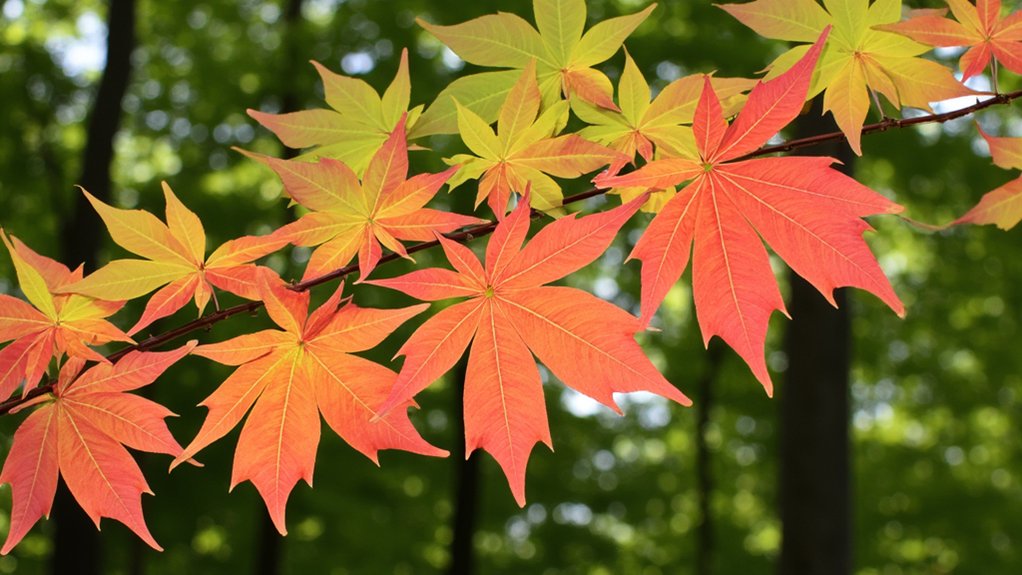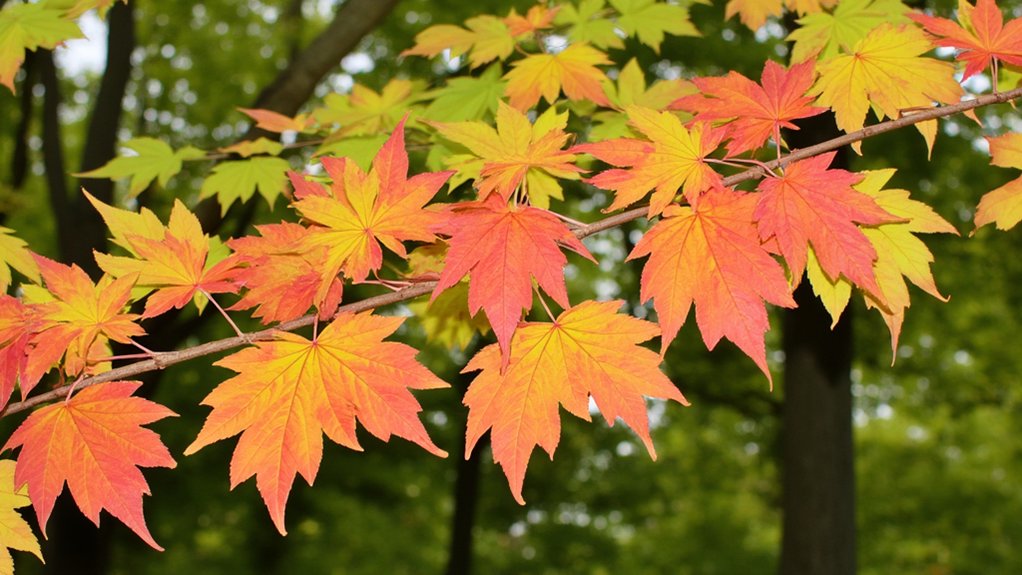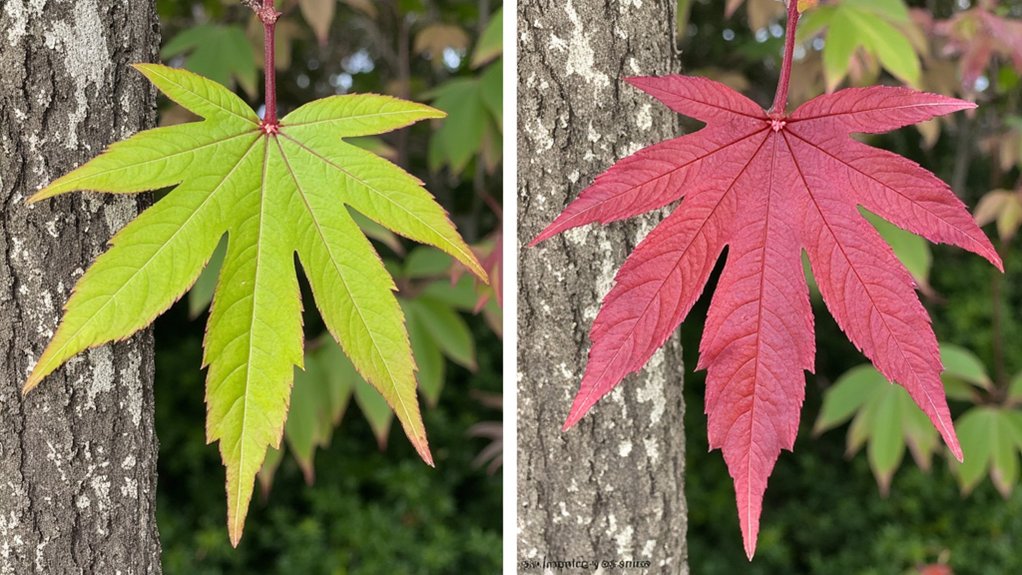You’ll find the color-changing abilities of plants both fascinating and predictable once you understand the science behind their transformations. While most people think autumn’s the only time plants display their dramatic color shifts, you’d be surprised to learn that temperature, soil chemistry, and even stress factors trigger these changes year-round. Beyond the familiar maple trees, there’s an entire spectrum of species that put on impressive displays through complex biological processes.
Contents
- 1 The Science Behind Plant Color Changes
- 2 Seasonal Color-Changing Plants and Trees
- 3 Stress-Induced Color Transformations
- 4 Temperature and Light Effects on Plant Pigmentation
- 5 Soil Chemistry’s Role in Plant Color Variation
- 6 Notable Examples of Color-Changing Species
- 7 Growing and Caring for Color-Changing Plants
The Science Behind Plant Color Changes

When plants change color, they’re actually revealing complex chemical processes happening within their cells. You’ll find that most color changes occur when chlorophyll, the pigment responsible for green coloration, begins breaking down.
As chlorophyll diminishes, you can see other pigments that were there all along: carotenoids create yellows and oranges, while anthocyanins produce reds and purples. Temperature, light exposure, and soil pH all influence these transformations.
In deciduous trees, shorter days trigger hormonal changes that create an abscission layer, cutting off nutrients to leaves. This process typically takes 2-4 weeks and reveals nature’s hidden color palette.
Seasonal Color-Changing Plants and Trees

Throughout North America and Europe, you’ll find spectacular examples of seasonal color changes in both native and cultivated plants. Maples showcase vibrant transformations from green to red, while birch trees turn brilliant yellow before shedding their leaves in autumn.
You can spot Virginia creeper’s dramatic shift from summer green to deep crimson between September and October, while burning bush shrubs convert to intense scarlet. Japanese barberry displays a gradient of colors, starting with yellow-orange and progressing to rich burgundy.
Boston ivy, clinging to walls and fences, changes from glossy green to purple-red when temperatures drop below 50°F in fall.
Stress-Induced Color Transformations

Plants don’t just change color with the seasons – they’ll also transform their hues in response to environmental stressors. You’ll notice leaves turning purple when phosphorus levels drop below 0.5%, while nitrogen deficiency often triggers yellowing within 2-3 weeks of onset.
Water stress can cause dramatic changes, with leaves shifting from green to yellow or red within days. You might spot browning leaf edges when soil salinity exceeds 4.0 dS/m, or pale yellow patches developing when temperatures rise above 90°F.
These color transformations serve as your plant’s warning system, letting you know exactly what they need to thrive.
Temperature and Light Effects on Plant Pigmentation
Beyond environmental stress, the daily interplay of temperature and light creates fascinating color variations in your garden. You’ll notice your plants respond to both daily and seasonal light fluctuations, with leaves often appearing darker green in low-light conditions as chlorophyll concentrates to maximize photosynthesis.
Temperature plays an equally important role, especially in fall foliage. When temperatures drop below 45°F, you’ll see anthocyanin production increase in many plants, creating those vibrant reds and purples. During summer heat waves above 85°F, you might observe yellowing as plants reduce chlorophyll to protect themselves from light damage.
Soil Chemistry’s Role in Plant Color Variation
While nutrients impact a plant’s overall health, soil pH specifically influences how your plants display color. When you’re growing hydrangeas, for instance, you’ll notice their flowers turn blue in acidic soil (pH 5.5 or lower) but shift to pink in alkaline conditions (pH 6.5 or higher).
Your garden’s soil chemistry affects how efficiently plants absorb essential minerals like aluminum and iron. You can modify soil pH using amendments: add sulfur to increase acidity, or incorporate limestone to raise alkalinity. However, you’ll need to wait 3-6 months before seeing color changes, as these chemical reactions happen gradually.
Notable Examples of Color-Changing Species
Among nature’s most fascinating performers, several species showcase dramatic color alterations throughout their growth cycles.
You’ll find the Japanese maple’s leaves shifting from bright green to brilliant crimson as temperatures drop, while the Hydrangea macrophylla shifts between pink and blue based on soil pH levels. The Virginia creeper vine changes from emerald to deep scarlet within two weeks of autumn’s arrival.
In your garden, you might spot the Oxalis triangularis, or purple shamrock, folding its violet leaves at night and reopening them daily. The Chinese perfume plant displays pink buds that mature into pure white flowers over a 48-hour period.
Growing and Caring for Color-Changing Plants
Once you’ve selected your color-changing plants, you’ll need to create ideal growing conditions to guarantee vibrant transformations. Monitor soil pH levels weekly, keeping them between 5.5 and 6.5, and maintain consistent moisture without waterlogging the roots.
For best color changes, you’ll want to position your plants where they’ll receive 4-6 hours of morning sunlight. During changeover periods, apply a balanced 10-10-10 fertilizer monthly, and reduce watering by 25% to trigger more intense pigmentation.
Prune away any damaged foliage promptly, and protect your plants from temperature extremes by moving containers indoors when temperatures drop below 45°F (7°C).
